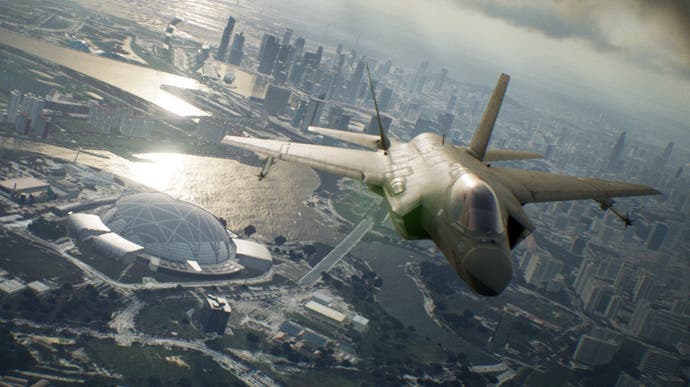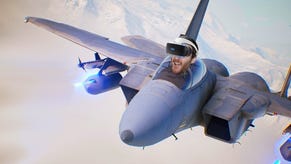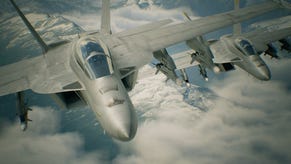Ace Combat 7: a classic series evolves with stunning visuals
But why does PS4 Pro outperform Xbox One X?
Ace Combat 7 is a superb sequel to a classic franchise that succeeds because it embraces new technology, but respects its past - and doesn't try to evolve the series into something it was never meant to be. There are all-new visuals, missions and game modes, but its connection to the past remains fundamental to its success. It's a proper sequel to the brilliant Ace Combat 5 (a decent port of which is bundled with PS4 pre-orders - and it runs at 4K60 on Pro), with gameplay evolved from AC4 and AC5. However, the fundamental technology has changed: similar to the Tekken and Soulcalibur titles, a proprietary game engine has been ditched for Unreal Engine 4, but thankfully the move pays off handsomely for the most part, with larger environments, lots of destruction and more on-screen entities.
For this new game, the developers have built everything from scratch. All new plane models, new scenery and a lot of new visual features are on display while the move to current-gen hardware enables a wide range of new visual effects, some of which have a direct impact on gameplay. Perhaps the most impressive addition is the introduction of volumetric cloud cover. Such systems have become increasingly common this generation but most games with this feature tend to be ground-based. Ace Combat 7, however, has players diving in an out of cloud cover. These clouds appear as thick volumes which you can fly through. They are impacted by light, such as that from the sun, and ice and rain are taken into consideration.
Fly through a dark cloud and your visibility is reduced significantly, which is key as this feature is also used for gameplay purposes - it's more difficult to lock-on to or see the enemy through clouds, somewhat implausibly you can cloud-cover to hide from radar detection. This is the first time in series history that cloud cover plays a significant role in mission design and the twist it adds to gameplay is sensational. Along those same lines, Ace Combat 7 introduces weather which can impact your flight performance. In one mission, while flying through tight spaces, strong bursts of wind can throw your plane off course while, later, blasts of lightning can temporarily interrupt your instruments forcing you to fly blind.
These weather patterns are represented with a series of beautiful effects. Rain particles fill the screen at points while globules of water collect on your view screen. Heat wave effects return as well, often visible around the plane's exhaust port while vapor trails are visible across the sky with thick, beautiful particle rendering. Other cinematic effects are included as well - a subtle film grain is utilised to increase the sense of realism while depth of field features a uniquely grainy appearance that gives the impression of being shot with a camera using a high ISO setting. A subtle motion blur is also featured throughout - it's kept to a minimum during gameplay to reduce blur during rotation but it's amped up during the main real-time cutscenes.
It's not just about how the UE4 feature set, but in how it is showcased by the developers. During flight, a dynamic camera system is used to enhance the action. When playing with the expert control option - which is just the previous standard for the series - the camera feels more natural than previous games while the standard option, which provides an arcade-like experience, features very dramatic camera movement. Terrain is beautifully textured, and materials now appear physically-based, lending the whole presentation a more realistic appearance. Object density is also improved though, regrettably, pop-in is visible across all platforms during flight - something especially evident in forested areas or dense urban environments.
All of this is designed to operate at 60 frames per second, just like the PS2 installments - a breath of fresh air after the last generation of Ace Combat games targeted 30fps instead. Everything just feels cohesive and beautifully crafted. Everything from the UI, the visuals and even the story telling are reminiscent of Namco's best work during the early to mid-2000s. It's a tremendous production, but the extent to which the ambition is realised in the final product depends very much on the hardware you're using to play the game. Those hoping for platform parity across consoles (resolution apart) are in for a disappointment, while PC users may be pleasantly surprised.
In terms of pixel-counts, there's no doubt that Ace Combat 7 falls a touch short. At the bottom of the pile sits the regular old Xbox One which runs at 720p - not uncommon with UE4 on the system but still disappointing. The game is noticeably blurrier than the other versions and that even includes the HUD and text elements, which could easily render at 1080p. Performance also falls short here; frame-rate is unlocked, but with dips to the mid-30s, this is clearly not what the developers had in mind when producing this game. Remember when we said that the Xbox One S was falling behind noticeably in multi-plat titles? Well, here's another obvious example.
Next up in the base PS4 which appears to run at 972p or something close to it, with briefing and hangar sections running at 1080p. Bearing in mind that the generation was mostly defined by this console delivering native 1080p visuals, it's a slight disappointment - but it is in similar to Namco's other UE4 titles running on base console hardware. Performance is mostly in 50fps territory on this one; it's OK, but again, there is the sense that a locked 60fps is where this game really needs to be.


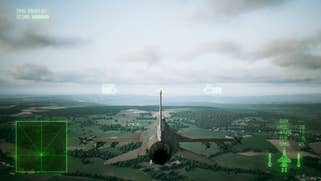
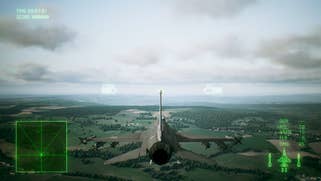
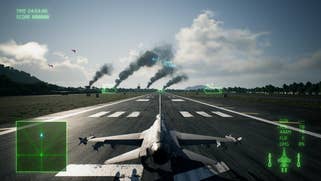

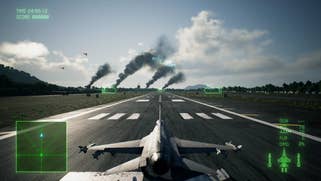



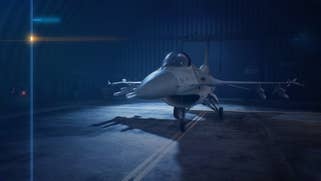
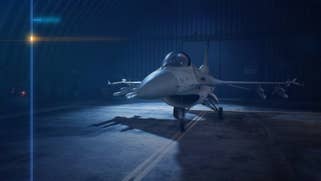

And a locked 1080p60 is what you get with the PlayStation 4 Pro version of the game. Again, we'd expect better from an enhanced console, but it is noticeably sharper than the Xbox One game, an incremental boost over PlayStation 4's presentation but on the plus side, AC7 on the Pro does indeed deliver 60fps for the vast duration of the action with only minor dips in specific missions. It's also closely matched by the Xbox One X version. Bizarrely, Microsoft's six-teraflop beast is still locked to full HD resolution and worse still, it's actually less stable than the Pro version in performance terms and doesn't seem to have quite the same level of clarity as its Sony equivalent. It's a baffling state of affairs, and clearly not the best utilisation of the hardware but at the very least, you're still getting a vast improvement over the lacklustre Xbox One S game.
It also seems to be the case that the visual feature set is a match across all four console versions. That said, volumetric clouds on Xbox One S do seem to render at a lower base resolution . The clarity of the console builds is Ace Combat 7's Achilles heel: the game is stunning in motion, and the utilisation of UE4's features in crafting a new aesthetic for this fallow franchise is superb. It's just a shame that the top-end presentation here is a mere 1080p, even on the most powerful console hardware. Thankfully though, there is an alternative - the PC version.
Again, quite possibly owing to its multi-platform Unreal Engine 4 roots, AC7 is also available on PC, enabling resolutions well beyond 1080p with additional options. There's no doubt that it looks dramatically better, that you're getting the most out of the artists' hard work. I played the game at native 4K locked to 60fps on a Titan Xp (a touch more powerful than a GTX 1080 Ti) which does suggest decent scalability across lower resolutions on cheaper hardware. Based on what I played, breaking the 1080p barrier shouldn't be too difficult on a range of hardware - though it's a touch unfortunate that HUD elements are still full HD assets.
The PC version also features a robust options menu which allows for plenty of scalability, in addition to support for frame-rates above 60fps, but there are some disappointments here. Ultrawide resolutions are not currently supported, while the only anti-aliasing option is FXAA. I'm not sure Unreal Engine 4's temporal anti-aliasing solution would be a good fit for this type of game, and obviously MSAA is off the table. Also, the console focus has introduced some hard limitations you can't power past. For example, it isn't really possible to push detail levels beyond what the consoles deliver. Pop-in is still an issue, for instance, but overall it's a decent PC release, even if it's not quite perfect. Maybe modding can resolve some of these minor issues.
Overall though, if you can't play on PC, PS4 Pro is the best way to go - and how it manages to deliver marginally smoother performance than Xbox One X is a bit of a mystery. Maybe it's the case that the platform-exclusive PSVR mode may have prompted additional optimisations on the PlayStation consoles? Certainly, the PSVR offering is impressive and a lot of fun. It's not the full game - indeed, it's just three missions, but it's a great bonus mode and if you have the means, I urge you to check it out. The immersion level is high and it feels absolutely amazing to soar through the skies in VR - it gave me that feeling of riding a roller coaster but without motion sickness. This one will push your stomach, though, so be warned.
What I really like about this mode is how it allows you to appreciate the fine details in the cockpit - the micro-abrasions on the cockpit glass glistens in the sun, for instance, while all the little controls within the cockpit are fully modeled and feel realistic thanks to the new materials system. Plus, being able to track your enemies with your head feels great - it's very immersive! It's just a shame this mode isn't available for PC owners - I'd love to play with my Oculus Rift, for instance, but alas, it's just not possible.
Looking at the overall picture then I think it's fair to say that Ace Combat 7 is mostly a success. The game itself is a phenomenal follow-up to the best in the series and the only issues I can level at the game stem from sub-par performance on base consoles and lower than expected resolutions on PS4 Pro and Xbox One X - and the lack of ultrawide support on PC. The rest of the presentation is brilliant and it's one of the more consistently beautiful games I've played recently. The variety in scenery and the quality of the rendering cannot be understated - it's simply a gorgeous game.
Beyond the technical specs, the game itself receives my highest recommendation. Having spent time playing many of the earlier games in the series this is the evolution I was looking for - the team understands the appeal of Ace Combat and sought to improve upon those core design tenants. The Project Aces team resisted the open world craze, dodged the 'games as a service' trap and stuck to its guns to produce a brilliant experience.
